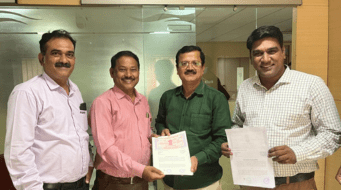By Vikas Prakash Joshi & Isha Fuletra
On the occasion of Renewable Energy Day, or Akshay Urja Din, celebrated on August 20 every year, it is worth looking at the progress of the renewable energy industry in India in the last decade or so. As of May 2018, renewable energy (RE) constitutes 17 percent of the total energy mix in India, up from 4.5 percent in 2002.
India has set an ambitious target of 175 Giga Watts by 2022 as its RE target. This, as per some reports, is the biggest renewable energy expansion programme in the world. Both solar and wind power tariffs have fallen to 2.44 and 2.43 per unit respectively, and are likely to fall further with more installations. The RE sector could generate up to 3,00,000 jobs in the coming years as per reports in the media.
Not surprisingly, such a rapid expansion has thrown up its own significant challenges. With that in mind, we decided to speak to Ashwin Gambhir, a Fellow at Pune-based Prayas Energy Group, an advocacy body working in the field of energy policy, to get his insights on the RE space in India and how it is likely to shape up in future.

About Ashwin Gambhir:
Ashwin Gambhir who is now a Fellow at Prayas Energy Group leads the work on renewable energy policy and regulatory research and advocacy.
There has been a tremendous growth in the RE sector in the recent past. What are your views on India’s RE sector?
There is no doubt that the last two years have been record years in terms of megawatt-scale and utility scale projects in the RE sector. The two areas which stand out within this sector are solar and wind power as the bulk of RE in India comes from them, while only a small percentage is contributed by the bagasse/biomass or small hydro plants.
Three to four years ago the sector was quite limited, mainly due to the high price issue. But in the recent past, the fall in tariffs indicates that renewable energy is now a very competitive option.
Which Indian states do you think have a good track record in renewable energy?
Generally, the western and southern states have a good record in RE as these resources are more abundant there. Specifically, Tamil Nadu, Karnataka, Maharashtra, Rajasthan and Telangana have a good record in solar and wind energy sector.
How do you see the relationship between RE and agriculture?
Historically, the main use of RE in agriculture for energy and irrigational purposes was restricted to a wind powered water mill, but this was very limited in its spread.
Another example is solar powered pumps. These were extensively implemented in Rajasthan but faced many challenges. There are price related issues, as one has to have to pay for all its cost upfront unlike a diesel pump. The cost of a 5 hp AC solar pump ranges between Rs. 3.25 and 3.5 lakh.
Moreover, solar pumps work well in areas of low water table. In all, the utilization of that asset goes down tremendously on a daily basis while the expenditure remains quite high.
As an alternative, solar agricultural feeder is much more affordable and effective. This involves tail end distributed solar PV plants (2-10 MWs) dedicated to agriculture feeders, connected at the sub-station.This approach is not just more cost effective than solar pumps, but also compared to supplying power from the central grid. Further it involves no subsidies and is much more scalable and has the ability to reduce cross subsidies and direct revenue subsidies from the state Govt.
There are reports that 15-20 percent renewable energy is wasted due to lack of adequate storage facilities and grid failure, do you think that government should work on balancing the demand supply equation and better storage facilities, over promoting growth in renewable energy generation?
The new bidding guidelines for wind and solar have proposed compensation for curtailment, or backing down of power. But at the same time, all solar and wind power projects have a Must-Run status as per the Grid Code, so they cannot be backed down unless there is a system emergency.
When a company bids for a project with a quote price an underlying assumption is made that all the power generated will be sold out to the buyer. So getting this demand supply balance is important. It is not that easy to get the demand supply balance perfectly right in this sector as the demand of energy varies across seasons and year, or even with time of the day.
Cheap Chinese imports have dramatically reduced solar power tariffs but at the cost of Indian domestic solar panel businesses. What are your views on this trade off?
The main trade off is whether we want the cheapest solar energy or slightly higher cost solar power from Indian solar panels. In any case, our manufacturing capacity is very limited compared to the demand of over 10 GW/year, hence imports in the short run are inevitable. In the WTO case against domestic content requirements, the WTO ruled against India. And so, from October 2018 domestic content requirement will no longer be in place. The new 10 GW solar tender from the Solar Energy Corporation of India has an inbuilt manufacturing component of 3-5 GW, which can spur new solar panel manufacturing in India.
Despite the GOI’s approach on RE, we are also aggressively expanding coal power generation and gas based electricity too. How do you see this?
We may have 20 to 21 percent generation share of RE by 2022 and by 2027 it may go up to 30 percent, optimistically speaking. But 100 % RE seems too unrealistic for a long time to come. So far as coal and conventional forms of energy are concerned, we need sources of energy that can continue when solar and wind are not available.
The GoI has set a target of 175 GW of RE by 2022. Is this really a realistic target?
Most analysts expect that the tariffs of RE to reduce even further, so prima facie the given target is achievable. We see that the Union Power Ministry and States are focused on achieving the target, and there has been no official statement stating that the target seems difficult to achieve or unrealistic. The solar rooftop segment is the only one lagging behind on yearly targets.
What are the major challenges facing the RE sector going forward?
In the past, the main challenge was the high tariffs. This is now no longer an issue. The real challenge going forward will be integrating RE within the electricity grid. The weather dependent wind and solar energy needs to be cost-effectively and reliably integrated into the system operation, without affecting the security and stability of the grid.





